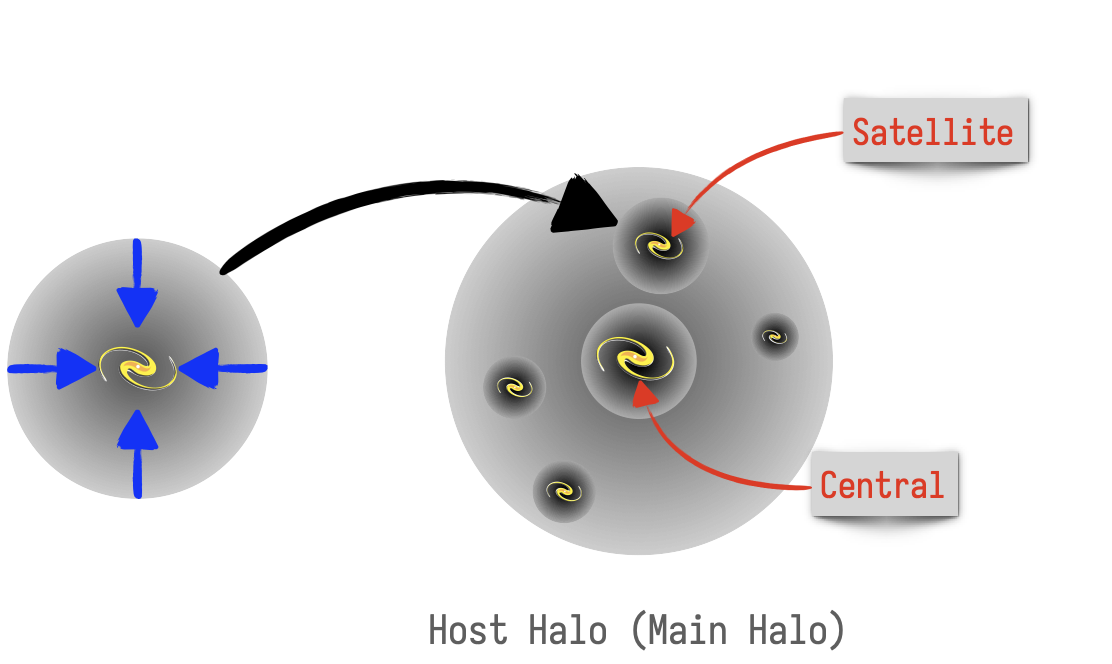The halo model of galaxy formation and evolution
May. 29, 2023
Here we draw a simplified physical picture about the formation of dark matter halos and galaxies, and how they are connected to each other.
Inhomogeneity in our Universe
Large galaxy surveys reveal the inhomogeneity of our Universe in a sense that galaxies are spatially clustered, rather than uniformly distributed. This inhomogeneity originates from the small density fluctuation in our primordial Universe, which is then amplified by gravity. On the other side, our Universe comprises 70% dark energy, 25% dark matter, and 5% baryon. And since dark energy is believed to be absolutely uniform in our current understanding, the inhomogeneity in our Universe is from dark matter and baryon.
The formation of halos and galaxies
The final state that an over-dense region can be amplified is a virialized structure called dark matter halo, when the pressure from the random motion of dark matter particles equilibrate the attracting gravity. These dark matter halos are the basic "elements" that compose the large-scale structure in our Universe. The final virial equilibrium state can be reached since dark matter cannot emit these kinetic energy away through electromagnetic radiation, which can be done for baryons. When the inhomogeneity is not so large, baryons basically follow the dark matter. However, when the inhomogeneity becomes large enough, baryons in over-dense regions will collide with each other and excite the electron to higher energy states, which will then decay to the ground level and emit a photo. Through this process, baryons can emit their energy away and keep collapsing. Formally speaking, this difference between dark matter and baryon is due to that the former is "collisionless" while the latter is "collisional".
After emitting their energy away through radiation, baryons can collapse into smaller scales and reach higher kinetic energy, i.e. higher temperature. Eventually, the nuclei reaction can be triggered and stars are formed. Stars, unlike gaseous baryons, are collisionless, so they can also reach the final state of virial equilibrium. And the assemble of these stars is called a galaxy.
Galaxy-halo connection
Galaxies are formed and evolved in dark matter halos, so strong correlations between their properties are expected. A representative connection is the stellar mass-halo mass relation (SHMR), which is a tight positive correlation between the galaxy stellar mass and the dark matter halo mass.
First, this positive correlation is expected since baryons follow the spatial distribution of dark matter in primordial universe so that more massive halos have more abundant baryons to be converted into stars. Second, this relation is not linear. Instead, it can be described by a double power-law function with the stellar conversion efficiencies suppressed at both the low-mass and high-mass ends. The peak efficiency appears at $\sim 10^{12}M_\odot$, i.e. the halo mass of our Milky Way.
The underlying physics to suppress the stellar conversion efficiency at both ends is still under debate, but some promising mechanisms are advocated. For low-mass halos, the stellar and supernovae feedback processes can effectively suppress the star formation activities by eject baryons out of their shallow gravitational potential. For massive halos, two major mechanisms are at work. The first one is that the accreted gas is shock-heated to very high temperature and they cannot be easily cooled down. The second one is that the energetic feedback from the accretion of super-massive black holes in the galaxy center can push baryons out of the galaxy and keep them hot to prevent their infall.
Central/satellite dichotomy
Halo merger and galaxy merger
The above narrative draws a simple picture for halo formation and galaxy formation for an isolated system. However, halos and galaxies are interacting with each other.
Dark matter halos will merger with each other under gravity. These halo merger events will also bring galaxies together. Since halos and galaxies differ a lot in their size, there is a time delay between the halo merger and the galaxy merger. During this time duration, multiple galaxies and their subhalos share a common dark matter halo, and they are referred to as galaxy group/cluster (Note: A massive galaxy group with halo mass above $10^{14}M_\odot$ is called a galaxy cluster).
Most of the halo mergers are minor mergers, i.e. a small halo is merger with a much larger halo. In these situations, we expect that the larger halo is nearly intact, while the smaller halo and the corresponding galaxy is moving toward the center of the larger halo under gravity. This difference establish the dichotomy of member galaxies in each galaxy group: a relatively massive central galaxy in the group center with small relative motion to the host halo, and zero to multiple relatively low-mass satellite galaxies moving relatively fast around the group center.
Environmental effects on satellite galaxies
The deviation from the group center and the fast relative motion make satellite galaxies subject to various environmental effects. First, their matter accretions, dark matter and baryon, are halted. Without these fresh gas replenishment, the star formation activities of these galaxies cannot be sustained once the existing gas is consumed. This effect is called starvation or strangulation. Second, their large relative velocity with respect to the host halo cause the hydrodynamical interaction between the cold interstellar medium (ISM) and the hot intra-cluster medium (ICM). When this interaction becomes strong enough, the cold ISM will be stripped out of the satellite galaxy, which will also affect the subsequent evolution of these galaxies. This effect is called the ram-pressure stripping. Third, since satellite galaxies have finite size, they will also suffer from the tidal force exerted by the host halo, which can alter the kinematics of satellite galaxies. Finally, the interaction between the subhalo and the host halo can decelerate the angular motion of the satellite subhalo and make them fall into the center of the host halo, which will cause the subhalo and the galaxies in it to merge with the central galaxy. This interaction is called dynamical friction, and the final galaxy merger is call cannibalism.
Summay in one figure
